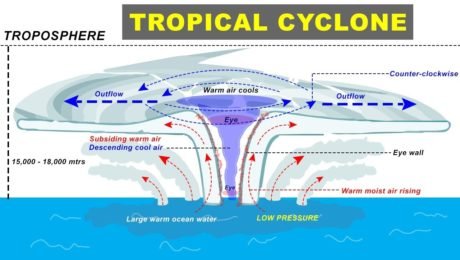Context– Tropical cyclones occur in the months of May-June and October-November. Cyclones of severe intensity and frequency in the North Indian Ocean are bi-modal character, with their primary peak in November and secondary peak in May.
This cyclone is named Mocha (Mokha), a name suggested by Yemen after the Red Sea port city, which is known to have introduced coffee to the world over 500 years ago.
Factors responsible for forming a tropical cyclone
- – High sea surface temperatures that are over 27 degrees Celsius.
- – Presence of Coriolis force /sufficient distance from the equator for a spin such as Coriolis force takes place.
- – Atmospheric instability
- – Small variation in vertical wind speed/ lower level of wind shear allows storm clouds to rise vertically to a high level
- – Pre-existing weak low-pressure area/low-level cyclonic circulation.
- – There should be anticyclonic circulation at the height of 9000 to 15000m above the surface disturbance. The upper air anticyclonic circulation sucks the air from the ocean surface above and thus the upward movement of air is accelerated and the low-pressure center at the surface is further intensified.
- – Upper divergence above the sea level system.
- – Increase the humid lower to the middle level of the troposphere.
How tropical cyclone is formed?
- – Warm, moist air over the ocean rises due to less density. This air rises up and away from the ocean surface, leaving less air near the surface, creating a low-pressure zone.
- – Due to the surrounding high-pressure areas, air flows into this low-pressure area and eventually warms up, forming a cycle.
- – Now, this cycle makes the warm air above the ocean rise and cool the water below to generate clouds. With the constant heating and evaporating process, the entire cloud and wind system spins and grows.
- – With more speed, cyclone eye formation takes place in the centre. This zone signifies the lowest air pressure and is calm and clear. The high-pressure air from above flows down into this region.
- – Cyclone is composed of cumulonimbus clouds that produced torrential rain.
- – The pattern of wind direction of cyclones in the northern hemisphere is anticlockwise direction.

How are tropical cyclones formed?
Cyclone category
- Cyclones are classified into five different level on the basis of wind speed and damage capacity

How cyclones are named?
- – Cyclones that form in every ocean basin across the world are named by the regional specialized meteorological centers (RSMCs) and Tropical Cyclone Warning Centers (TCWCs).
- – There are six RSMCs in the world, including the India Meteorological Department (IMD), and five TCWCs
- – As an RSMC, the IMD names the cyclones developing over the north Indian Ocean, including the Bay of Bengal and the Arabian Sea, after following a standard procedure.
- – The IMD is also mandated to issue advisories to 12 other countries in the region on the development of cyclones and storms
- – In 2000, a group of nations called WMO/ESCAP (World Meteorological Organization/United Nations Economic and Social Commission for Asia and the Pacific), which comprised Bangladesh, India, the Maldives, Myanmar, Oman, Pakistan, Sri Lanka and Thailand, decided to start naming cyclones in the region.
- – The names are listed alphabetically country-wise and are neutral gender-wise.
- – After each country sent in suggestions, the WMO/ESCAP Panel on Tropical Cyclones (PTC) finalised the list.




